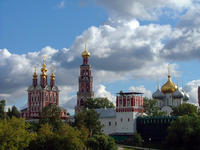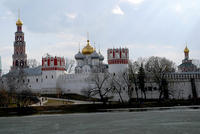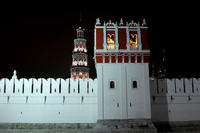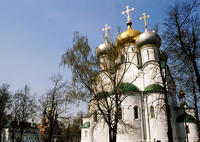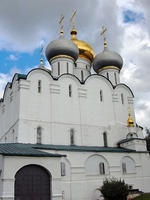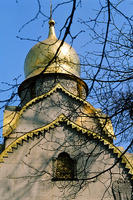You are in: Europe -> Russia -> Ensemble of the Novo... , and traditional search or Image Gallery will yield results of this site only
Ensemble of the Novodevichy Convent
| Site number: | 1097 |
|
| Type of site: | Cultural | |
| Date: | 16-17th century | |
| Date of Inscription: | 2004 | |
| Location: | Eurasia, Russian Federation, City of Moscow | |
Up to 75 images are shown here. Click on each for more details or on Image Gallery for more images.
| Description: | The 16th and 17th century Novodevichy Convent, in south western Moscow, was part of a string of monastic ensembles that were incorporated into the city’s defense system. Directly associated with Russia’s political, cultural and religious history, the Convent was also closely linked to the Moscow Kremlin. The women of the Tsar’s family and of the aristocracy regularly used the convent; the Tsar’s family Members and entourage were also buried in its cemetery. The Convent offers an example of the highest Russian architectural accomplishments with prosperous interiors and a significant painting and artifact assortment. --WHMNet paraphrase from the description at WHC Site, where additional information is available. | |
| Novodevichy Convent, also known as Bogoroditse-Smolensky Monastery (Russian: Новоде́вичий монасты́рь, Богоро́дице-Смоле́нский монасты́рь) is probably the best-known cloister of Moscow. Its name, sometimes translated as the New Maidens' Monastery, was devised to differ from an ancient maidens' convent in the Moscow Kremlin. Unlike other Moscow cloisters, it has remained virtually intact since the 17th century. In 2004, it was proclaimed a UNESCO World Heritage Site. The Novodevichy Convent was founded in 1524 by Grand Prince Vasili III in commemoration of the conquest of Smolensk in 1514. It was built as a fortress at a curve of the Moskva River and became an important part of the southern defensive belt of the capital, which had already included a number of other monasteries. Upon its founding, the Novodevichy Convent was granted 3,000 rubles and the villages of Akhabinevo and Troparevo. Ivan the Terrible would later grant a number of other villages to the convent. The oldest structure in the convent is the six-pillared five-domed cathedral (picture), dedicated to the icon Our Lady of Smolensk. Extant documents date its construction to 1524–1525; yet its lofty ground floor, magisterial proportions, and projecting central gable are typical of monastery cathedrals built at the behest of Ivan the Terrible. Most scholars agree that the cathedral was rebuilt in the 1550s or 1560s; it was formerly ringed by four smaller chapels, in an arrangement reminiscent of the Annunciation Cathedral in the Kremlin. Its frescos are among the finest in Moscow. The cathedral may be a focal point of the monastery, but there are many other churches. Most of them date from the 1680s, when the convent was thoroughly renovated at the behest of the regent Sophia Alexeyevna (who, ironically, would be incarcerated there later). The blood-red walls and crown-towers, two lofty over-the-gates churches, a refectory, and residential quarters were all designed in the Muscovite Baroque style, supposedly by a certain Peter Potapov. In the old cathedral, a new bowl for holy water and gilded carved iconostasis were installed in 1685. Its four tiers contain 16th-century icons endowed by Boris Godunov; the fifth tier displays icons by leading 17th-century painters, Simeon Ushakov and Fyodor Zubov. An arresting slender belltower, also commissioned by Sophia, was built in six tiers to a height of 72 metres, making it the highest structure in 18th-century Moscow (after Ivan the Great Bell Tower). This light octagonal column seems to unite all major elements of the ensemble into one harmonious whole. --Wikipedia. Text is available under the Creative Commons Attribution-ShareAlike License. | ||
| Source: | http://whc.unesco.org/en/list/1097 | |
| Reference: | 1. UNESCO World Heritage Center, Site Page. | |






